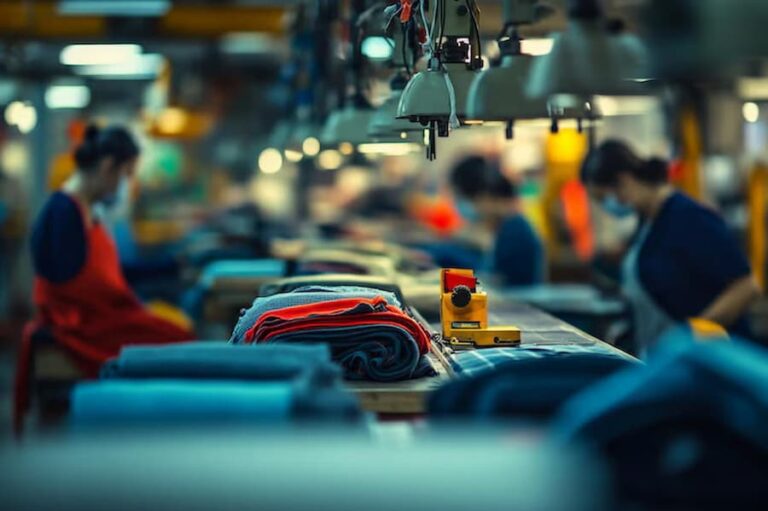The fabric Industry is witnessing a transformative phase driven by technological advancements that are reshaping manufacturing processes, product design, and consumer guests. From the development of smart fabrics to the relinquishment of robotization in products, technology is revolutionising the way fabrics are created, used, and interacted with. These inventions at T&A textiles Manchester not only improve effectiveness and sustainability but also open up new possibilities for creativity and customization. As technology continues to evolve, its influence on fabric industry is getting more profound, offering innovative openings for manufacturers and consumers.
Robotization in Fabric Industry Manufacturing:
Robotization has significantly bettered fabric Industry manufacturing, enhancing productivity, perfection, and effectiveness. Ultramodern technologies like robotic weaving, knitting, and sewing machines streamline product processes, reducing labour costs and mortal error. Automated systems can work continuously without fatigue, adding affair and enabling brisk product cycles. This also allows for further complex patterns and designs to be woven with minimum homemade intervention. As a result, manufacturers can meet the added demand for Fabric while maintaining harmonious quality and reducing product time. Also, robotization can help minimise waste by optimising material operation, contributing to both cost savings and sustainability in the assiduity.
Smart Fabrics and Wearables:
Smart fabrics and wearable technologies are gaining traction in fabrics assistance, creating innovative fabrics that can interact with the terrain or respond to stoner requirements. These fabrics integrate conductive filaments, detectors, and electronic factors, allowing for fabrics to cover vital signs, acclimate temperature, or indeed change colour. Operations range from health-monitoring garments to performance-enhancing apparel for athletes. The rise of smart Fabric is also creating openings for substantiated, functional apparel that adapts to wear and tear requirements. As technology evolves, the eventuality for garments to offer lesser convenience, comfort, and mileage expands, transubsting both the fashion and healthcare sectors.
Sustainability and Eco-Friendly Technologies:
Sustainability has become a crucial focus in fabric industry, driven by the demand for eco-friendly accoutrements and manufacturing processes. Technology is playing a vital part in promoting sustainability through inventions like recycled Fabric, arid dyeing technologies, and the use of biodegradable filaments. Advanced technologies allow manufacturers to reduce water, energy, and chemical consumption during products, significantly lowering the environmental footmark. Likewise, new technologies enable the creation of fabric from sustainable accoutrements similar to hemp, organic cotton, and bamboo, which offer an eco-conscious volition to traditional fabrics. As environmental enterprises continue to rise, sustainability-concentrated tech results are decreasingly essential in fabric manufacturing.
3D Printing and Customization:
3D printing technology is fabric-attentive by enabling customised designs and garments to be created on demand. This technology allows for the creation of intricate, customised cloth patterns and indeed entire garments without the need for traditional fabric product styles. By using digital designs and technical printers, 3D printing can reduce waste, as accoutrements are used only as demanded. Also, this process allows for lesser design inflexibility, offering consumers the capability to produce substantiated apparel with unique features. As 3D printing continues to develop, it’s anticipated to become a significant tool for both contrivers and consumers seeking individuality in fashion.
Digital Textile Printing:
Digital cloth printing technology is revolutionising how patterns, designs, and images are transferred onto fabrics. Unlike traditional screen printing, digital printing uses inkjet printers to apply designs directly onto the fabrics, allowing for high-resolution prints with minimum setup time and waste. This system offers significant advantages, such as the capability to produce complex, multi-colored designs with ease, as well as the inflexibility to publish small amounts or indeed-off particulars. Digital printing also reduces water and energy operations compared to traditional styles. As demand for unique, on-demand cloth prints grows, digital cloth printing is becoming a crucial invention in fabric industry.
Virtual Reality and stoked Reality in Design:
Virtual reality (VR) and stoked reality (AR) are decreasingly being used in the design and prototyping phases of fabric products. Contrivers can use VR to produce and fantasise digital prototypes of fabrics and garments, experimenting with textures, colours, and patterns before physically producing them. AR technology is also enhancing the shopping experience, allowing consumers to see how a piece of apparel might look on them or fantasise about fabric choices in real time. This immersive approach not only reduces design time but also improves delicacy and reduces the need for physical samples, which contributes to further sustainable product practices.
Conclusion – Fabric Industry:
Technology is dramatically reshaping fabric industry, bringing about inventions that better effectiveness, sustainability, and customization. From robotization and smart fabrics to eco-friendly product styles and advanced design technologies like 3D printing and digital printing, these advancements aren’t only enhancing the manufacturing process but also transforming consumer goods.
Keep visiting blogpedia for more informative blogs.
